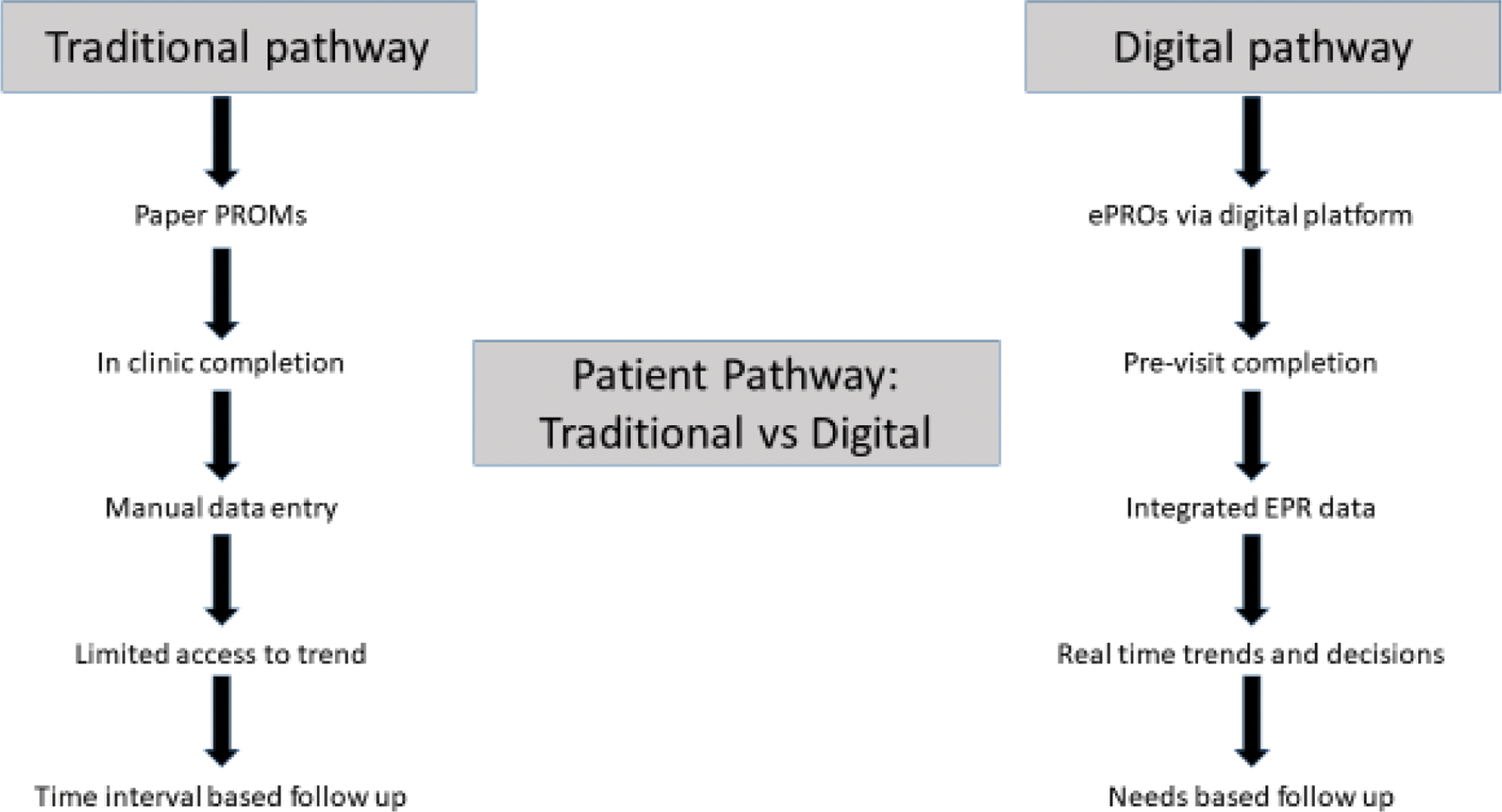

Background: The management of inflammatory arthritis (IA), including Rheumatoid Arthritis (RA), Axial Spondyloarthritis (axSpA), and Psoriatic Arthritis (PsA), requires accurate disease activity monitoring and timely interventions to achieve optimal outcomes. Traditional paper-based patient-reported outcomes (PROMs) often lacked completeness, hindered workflow efficiency, and limited their utility in routine practice. To address these challenges, the Rheumatology Department at Royal Berkshire NHS Foundation Trust implemented a fully integrated electronic patient-reported outcomes (ePROs) system within its digital care pathways. This system, designed for scalability and personalisation, enhances disease management while optimising clinic capacity.
Objectives: This study aimed to evaluate the effectiveness of a digitally integrated ePRO system by increasing PROM completion rates for comprehensive disease monitoring, reducing routine follow-ups through patient-initiated follow-ups (PIFU), maintaining a low new-to-follow-up ratio to optimize capacity and enhancing clinician-patient efficiency to prioritise high-need cases.
Methods: Between January 2022 and August 2024, ePROs were implemented via a patient engagement platform integrated with the hospital electronic patient record (EPR). PROMs, such as BASDAI, RAPID-3, PSAID-12 and HAQ-DI were sent to patients pre-visit, enabling remote completion and longitudinal monitoring of disease activity. A dynamic dashboard visualised trends and stratified patients by severity, facilitating timely interventions. Metrics such as completion rates, follow-up intervals, clinician time saved, and patient satisfaction were analysed. Comparisons were made with traditional workflows to highlight improvements.
Results: Electronic PROs were sent out to 2151 RA, 910 PsA and 722 axSpA patients during the period of the study. Patient Engagement: Completion rates exceeded 60%, with condition-specific rates of 62.8% (AS), 60.5% (RA), and 62.5% (PsA). These rates significantly exceeded pre-digital completion rates (<30%). Clinic Efficiency: The total clinic time saved over 36 months was 1,188 hours, or 396 hours annually. New-to-Follow-Up Ratio: the service achieved a ratio of 2.5, outperforming the national average of 4.2. User Feedback: Over 90% of clinicians rated the system as highly effective for integrating patient data into decision-making. Patients reported greater satisfaction, citing reduced travel and improved convenience.
Conclusion: This study demonstrates the transformative potential of integrating ePROs into IA care pathways. By enhancing disease monitoring, reducing in-person visits, and empowering patients as active participants in their care, the system significantly improved outcomes and clinic efficiency. The ePRO completion rates were above the average reported in literature (50-55%) [1]. The new-to-follow up ratio was lower than the national average with some hospitals reporting ratios as high as 10. The introduction of PIFU and virtual follow-ups saved clinical time. This allowed for reallocating resources to high-need patients, enabling timely reviews for flares or complex cases. This supports the drive to see the right patient at the right time [2]. Key challenges, such as digital literacy and data security, were mitigated through targeted training and robust infrastructure. Future plans include scaling this model to other conditions, such as SLE, and integrating predictive analytics to detect flares earlier, further optimising personalised care.
REFERENCES: [1] Arumalla et al., Arthritis Rheumatol. 2023; 75:1892-1903.
[2] Chan et al., Nat Rev Rheumatol. 2023 Nov;19(11):680-681.
The traditional versus digital pathway used with the implementation of an integrated electronic patient reported outcome (ePRO) platform.

Acknowledgements: NIL.
Disclosure of Interests: Antoni Chan Speakers bureau for UCB, Abbvie, Novartis, Janssen, Amgen, Kathryn Rigler: None declared, Nneoma Zabbey: None declared, Mustansar Hussain: None declared, Andrew Hubbard: None declared.
© The Authors 2025. This abstract is an open access article published in Annals of Rheumatic Diseases under the CC BY-NC-ND license (